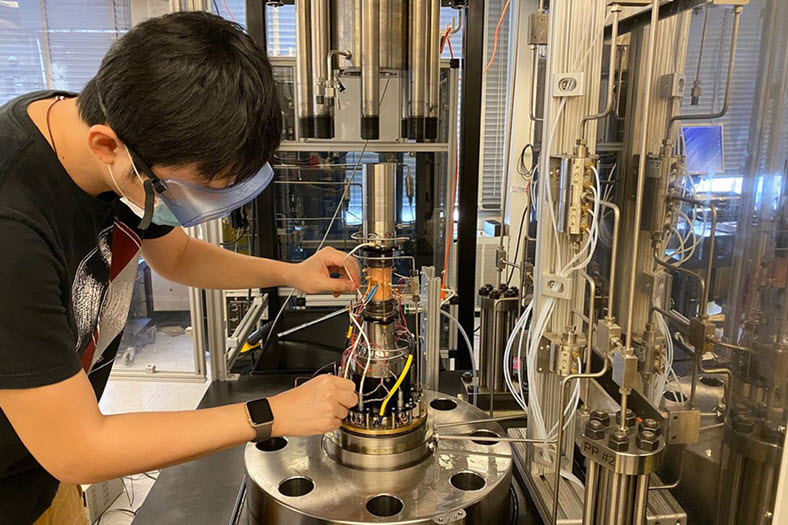
The Carbon Capture, Utilization, and Storage Center, one of the MIT Energy Initiative (MITEI)’s Low-Carbon Energy Centers, has awarded $900,000 in funding to two new research projects to advance technologies that avoid carbon dioxide (CO2) emissions into the atmosphere and help address climate change.
The winning project is receiving $750,000, and an additional project receives $150,000.
The winning project, led by principal investigator Asegun Henry, the Robert N. Noyce Career Development Professor in the Department of Mechanical Engineering, and co-principal investigator Paul Barton, the Lammot du Pont Professor of Chemical Engineering, aims to produce hydrogen without CO2 emissions while creating a second revenue stream of solid carbon. The additional project, led by principal investigator Matěj Peč, the Victor P. Starr Career Development Chair in the Department of Earth, Atmospheric and Planetary Sciences, seeks to expand understanding of new processes for storing CO2 in basaltic rocks by converting it from an aqueous solution into carbonate minerals.
Carbon capture, utilization, and storage (CCUS) technologies have the potential to play an important role in limiting or reducing the amount of CO2 in the atmosphere, as part of a suite of approaches to mitigating to climate change that includes renewable energy and energy efficiency technologies, as well as policy measures. While some CCUS technologies are being deployed at the million-ton-of-CO2 per year scale, there are substantial needs to improve costs and performance of those technologies and to advance more nascent technologies. MITEI’s CCUS center is working to meet these challenges with a cohort of industry members that are supporting promising MIT research, such as these newly funded projects.
Henry and Barton’s project, “Lower cost, CO2-free, H2 production from CH4 using liquid tin,” investigates the use of methane pyrolysis instead of steam methane reforming (SMR) for hydrogen production.
Currently, hydrogen production accounts for approximately 1 percent of global CO2 emissions, and the predominant production method is SMR. The SMR process relies on the formation of CO2, so replacing it with another economically competitive approach to making hydrogen would avoid emissions.
“Hydrogen is essential to modern life, as it is primarily used to make ammonia for fertilizer, which plays an indispensable role in feeding the world’s 7.5 billion people,” says Henry. “But we need to be able to feed a growing population and take advantage of hydrogen’s potential as a carbon-free fuel source by eliminating CO2 emissions from hydrogen production. Our process results in a solid carbon byproduct, rather than CO2 gas. The sale of the solid carbon lowers the minimum price at which hydrogen can be sold to break even with the current, CO2 emissions-intensive process.”
Henry and Barton’s work is a new take on an existing process, pyrolysis of methane. Like SMR, methane pyrolysis uses methane as the source of hydrogen, but follows a different pathway. SMR uses the oxygen in water to liberate the hydrogen by preferentially bonding oxygen to the carbon in methane, producing CO2 gas in the process. In methane pyrolysis, the methane is heated to such a high temperature that the molecule itself becomes unstable and decomposes into hydrogen gas and solid carbon — a much more valuable byproduct than CO2 gas. Although the idea of methane pyrolysis has existed for many years, it has been difficult to commercialize because of the formation of the solid byproduct, which can deposit on the walls of the reactor, eventually plugging it up. This issue makes the process impractical. Henry and Barton’s project uses a new approach in which the reaction is facilitated with inert molten tin, which prevents the plugging from occurring. The proposed approach is enabled by recent advances in Henry’s lab that enable the flow and containment of liquid metal at extreme temperatures without leakage or material degradation.
Source: MIT
Read the most up to date Fuel Cell and Hydrogen Industry news at FuelCellsWorks




